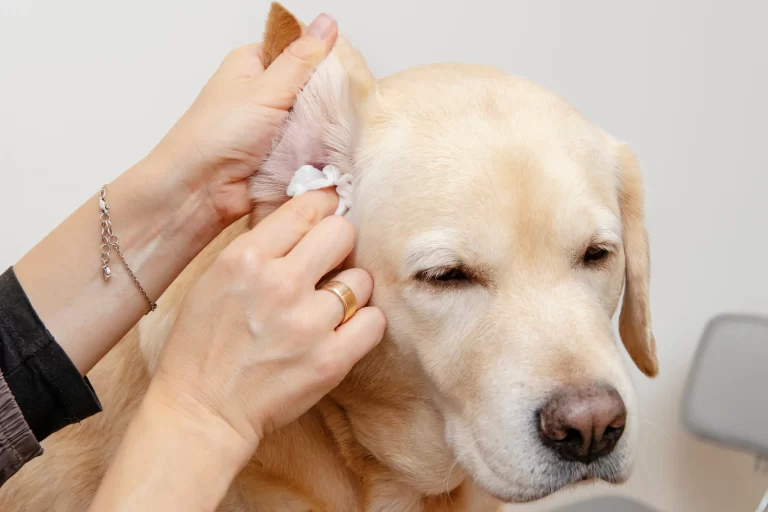A skin tag on a dog appears as a small, fleshy growth with a long stalk, typically the same color as the dog’s skin. Skin tags are often soft to the touch and may slightly protrude from the skin, resembling a wart-like bump.
Though they are usually harmless, it is important to monitor skin tags for any changes in size, shape, or color. If you notice multiple skin tags or any significant changes, it is advisable to consult a veterinarian for further evaluation.
In some cases, a biopsy may be necessary to rule out any underlying health concerns. Overall, skin tags on dogs are generally benign and do not cause discomfort unless they become injured or infected.

Credit: www.powerreviews.com
What Does A Skin Tag Look Like On A Dog
Skin tags on dogs are soft, slightly raised bumps that are usually the same color as the dog’s skin. They resemble flaps or wart-like growths and are not completely round or dark. If you notice any changes or numerous skin tags on your dog, it’s best to consult a veterinarian.
Appearance Of Skin Tags On Dogs
Skin tags on dogs are often the same color as a dog’s normal skin tone, soft, and shaped like a long stalk or teardrop. They typically have a smooth surface and can vary in size, ranging from a few millimeters to a few centimeters in diameter. Unlike warts or tumors, skin tags do not usually cause any discomfort or pain to the dog unless they get injured or infected. Additionally, skin tags tend to remain the same shape, size, and color over time and do not spontaneously bleed.Location Of Skin Tags On Dogs
Skin tags can appear on any part of a dog’s body, including the face, neck, chest, back, tail, and legs. However, they are most commonly found in areas where there is friction or rubbing, such as the armpits, groin, and under the collar. These areas are prone to moisture and sweat, which may contribute to the development of skin tags. It’s important to note that while skin tags can occur in any breed of dog, they are more commonly seen in older dogs.Difference Between Skin Tags And Other Skin Conditions
It can be challenging to differentiate skin tags from other skin conditions, such as warts or tumors. However, there are a few key differences to look out for. Firstly, skin tags are usually the same color as the dog’s normal skin tone, while warts and tumors may appear darker or have irregular colors. Additionally, skin tags have a characteristic stalk-like or teardrop shape, whereas warts and tumors often have a more irregular or cauliflower-like appearance. Lastly, skin tags are generally soft to the touch, while warts and tumors may feel harder or firmer. In conclusion, skin tags on dogs are typically soft, stalk-like growths that resemble a tear or a small piece of excess skin. They are often the same color as the dog’s normal skin tone and are commonly found in areas of friction or rubbing. While skin tags are generally benign and do not cause any discomfort, it is essential to monitor them for any changes in size, shape, or color. If you are unsure whether a growth on your dog is a skin tag or another skin condition, it is recommended to consult with a veterinarian for a proper diagnosis and treatment plan.
Credit: zigzag.dog
Treatment And Prevention Of Skin Tags On Dogs
Skin tags are common, benign growths that can appear on dogs of all breeds and ages. While they are generally harmless, it’s important to know how to effectively treat and prevent them to ensure your dog’s overall health and well-being. This section will discuss when to seek veterinary assistance, options for removing skin tags on dogs, and preventive measures for avoiding future skin tags.
When To Seek Veterinary Assistance
If you notice skin tags on your dog, it’s important to monitor them for any changes. While most skin tags are harmless, there are certain signs that should prompt you to seek veterinary assistance:
- If the skin tags are changing in size, shape, or color
- If your dog develops multiple skin tags
- If the skin tags are causing discomfort or irritation to your dog
Options For Removing Skin Tags On Dogs
If you decide to have your dog’s skin tags removed, there are several options to consider. It’s important to consult with your veterinarian to determine the best course of action for your furry friend. Here are some common removal methods:
- Surgical removal: In some cases, surgical removal of the skin tags may be necessary. This procedure is typically done under local anesthesia, and your dog will be closely monitored throughout the process.
- Cryotherapy: Cryotherapy involves freezing the skin tags with liquid nitrogen, causing them to fall off over time. This is a non-invasive option that can be effective for smaller skin tags.
- Topical treatments: There are various topical treatments available that claim to shrink or dissolve skin tags. However, it’s important to consult with your veterinarian before using any over-the-counter products to ensure their safety and effectiveness.
Preventive Measures For Avoiding Skin Tags On Dogs
While it may not be possible to completely prevent skin tags from developing on your dog, there are some steps you can take to reduce the risk:
- Maintain a healthy diet and weight for your dog: Obesity is believed to be a contributing factor to the development of skin tags in dogs. Providing a balanced diet and regular exercise can help prevent excessive weight gain.
- Groom your dog regularly: Regular grooming can help keep your dog’s skin clean and healthy, reducing the likelihood of skin tags.
- Avoid excessive skin irritation: Be mindful of any activities or products that may cause skin irritation, as this can increase the risk of skin tag formation.
- Regularly check your dog’s skin: By regularly inspecting your dog’s skin, you can catch any new skin tags early and seek veterinary assistance if necessary.
By being proactive in monitoring your dog’s skin and taking preventive measures, you can help keep your furry friend healthy and comfortable. Remember to consult with your veterinarian if you have any concerns about skin tags or any other skin conditions your dog may have.

Credit: www.hillspet.com
Frequently Asked Questions For What Does A Skin Tag Look Like On A Dog
What Does A Cancerous Skin Tag Look Like On A Dog?
A cancerous skin tag on a dog typically appears as a raised wart-like patch or lump that feels firm to the touch. These tumors are most commonly found on the dog’s head, lower legs, rear, and abdomen. It’s important to monitor skin tags for any changes and consult a veterinarian if you notice any growth changes or multiple tags on your dog.
How Do You Get Rid Of Skin Tags On A Dog?
Skin tags on dogs can be removed through surgery under local anesthesia. It’s important to monitor the tags for any changes and consult a veterinarian if they grow or multiply. Skin tags are usually the same color as the dog’s skin and are soft with a long stalk.
When Should You Worry About A Skin Tag On A Dog?
If you notice any changes in a skin tag on your dog, such as it becoming larger or if there are many of them, it’s important to visit your veterinarian immediately. They can examine the growth and determine if a biopsy is needed.
Monitor skin tags for any changes.
How Do You Know If It’s A Tick Or Skin Tag On Dog?
To determine if it’s a tick or skin tag on your dog: 1. Check the color: Skin tags match your dog’s skin color, while ticks are usually dark brown or gray. 2. Examine closely: If your dog has light-colored skin and fur, ticks are easier to spot.
For darker skin, use a magnifying glass. 3. Note the shape: Skin tags are soft, slightly raised, and can be shaped like a long stalk or teardrop. 4. Monitor for changes: Skin tags typically do not change in size, shape, or color.
If there are any changes, consult a vet. 5. Seek veterinary help: If you’re unsure or concerned, visit your veterinarian for a proper diagnosis.
Conclusion
Skin tags on dogs are usually harmless and appear as soft, slightly raised, skin-colored bumps or flaps. They can resemble warts but are not completely round or dark in color. It’s important to monitor skin tags for any changes and consult a veterinarian if there are any concerns.
If removal is necessary, it can be done through surgery under local anesthesia. Remember to seek professional advice if unsure about the nature of a growth on your dog’s skin.



